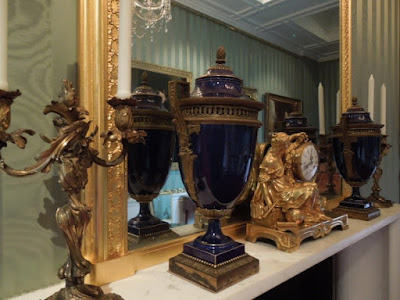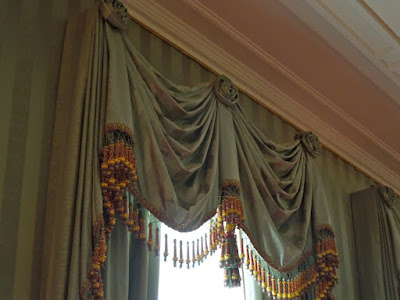Located in Bathurst, Australia (about a 3 hour drive west of Sydney) is Abercrombie House. This charming English country house style structure was built in the 1870s for William Stewart, the Lieutenant Governor General, or 2nd in command. Since 1969 it has been in the hands of the Morgan family who have restored the house and have it open to the public to help with funding for further care of the house.
Don't let "open to the public" fool you; this is a real family home which is probably the most interesting reason to visit the mansion. Staid house museums can sometimes be a tad boring (even I'll admit that) and seeing an active family in residence and how they live in period style is the main attraction here.
This Victorian house mixes elements from many genres but Gothic Revival might be an appropriate moniker if one must be chosen.
The furnishings are casual and old; nothing fussy. One might believe they have accumulated over generations of Stewarts.
The double parlor is of course very Victorian. Lovely plasterwork and colorful wallpaper lend the period aire.
The original marble mantel pieces really steal the show. Notice the Gothic door paneling to the left below. Piles of books and a fireplace..... heavenly.
The grand dining room looks right out of a period drama.
Much of the wallpaper is in fact original, including this William Morris wallpaper.
The William Morris wallpaper in detail has lovely shades of brown, ivory, and gilding.
The grand oak stair is lined with old family photographs.....
which continue up to the landing. Notice the much narrower stair to the 3rd level.
It's lovely to see these old rooms LIVED in. One of the sons is interested in anthropology which is evident in his taxidermy filled bedroom.
Notice the modern lamps mixed in amongst the antiques.
Their other son occupies another cool and shady bedroom -also full of antiques.
The very clean fireplace sadly doesn't look as if it has been used in years.
The gardens, which occupy 50 acres, are frequent hosts to weddings and events.
Notice the old green house at the rear of the house above along with utilitarian farm vehicles.
Further out back are vintage Austin Princesses in 'storage'.
Lovely old wrought iron surrounds the immediate gardens.
It's somehow reassuring in this age to see such houses really lived-in and in such time worn style! Thanks to Neal for supplying us with his gorgeous inspirational photos!
Don't let "open to the public" fool you; this is a real family home which is probably the most interesting reason to visit the mansion. Staid house museums can sometimes be a tad boring (even I'll admit that) and seeing an active family in residence and how they live in period style is the main attraction here.
This Victorian house mixes elements from many genres but Gothic Revival might be an appropriate moniker if one must be chosen.
Reminders of the Stewarts' native Scotland are abundant. If it weren't for the sunny Australian weather one might imagine oneself in the heart of the moors.
This tiled loggia looks like a lovely spot for afternoon tea. Notice the modern light fixtures lining the ceiling - I love seeing how the house has moved with the times.
Period details such as Gothic plaster arches and stained glass though proclaim the age of the house.The furnishings are casual and old; nothing fussy. One might believe they have accumulated over generations of Stewarts.
The double parlor is of course very Victorian. Lovely plasterwork and colorful wallpaper lend the period aire.
The original marble mantel pieces really steal the show. Notice the Gothic door paneling to the left below. Piles of books and a fireplace..... heavenly.
The grand dining room looks right out of a period drama.
Much of the wallpaper is in fact original, including this William Morris wallpaper.
The William Morris wallpaper in detail has lovely shades of brown, ivory, and gilding.
The grand oak stair is lined with old family photographs.....
which continue up to the landing. Notice the much narrower stair to the 3rd level.
It's lovely to see these old rooms LIVED in. One of the sons is interested in anthropology which is evident in his taxidermy filled bedroom.
Notice the modern lamps mixed in amongst the antiques.
Their other son occupies another cool and shady bedroom -also full of antiques.
The very clean fireplace sadly doesn't look as if it has been used in years.
The gardens, which occupy 50 acres, are frequent hosts to weddings and events.
Notice the old green house at the rear of the house above along with utilitarian farm vehicles.
Further out back are vintage Austin Princesses in 'storage'.
Lovely old wrought iron surrounds the immediate gardens.
It's somehow reassuring in this age to see such houses really lived-in and in such time worn style! Thanks to Neal for supplying us with his gorgeous inspirational photos!























































































